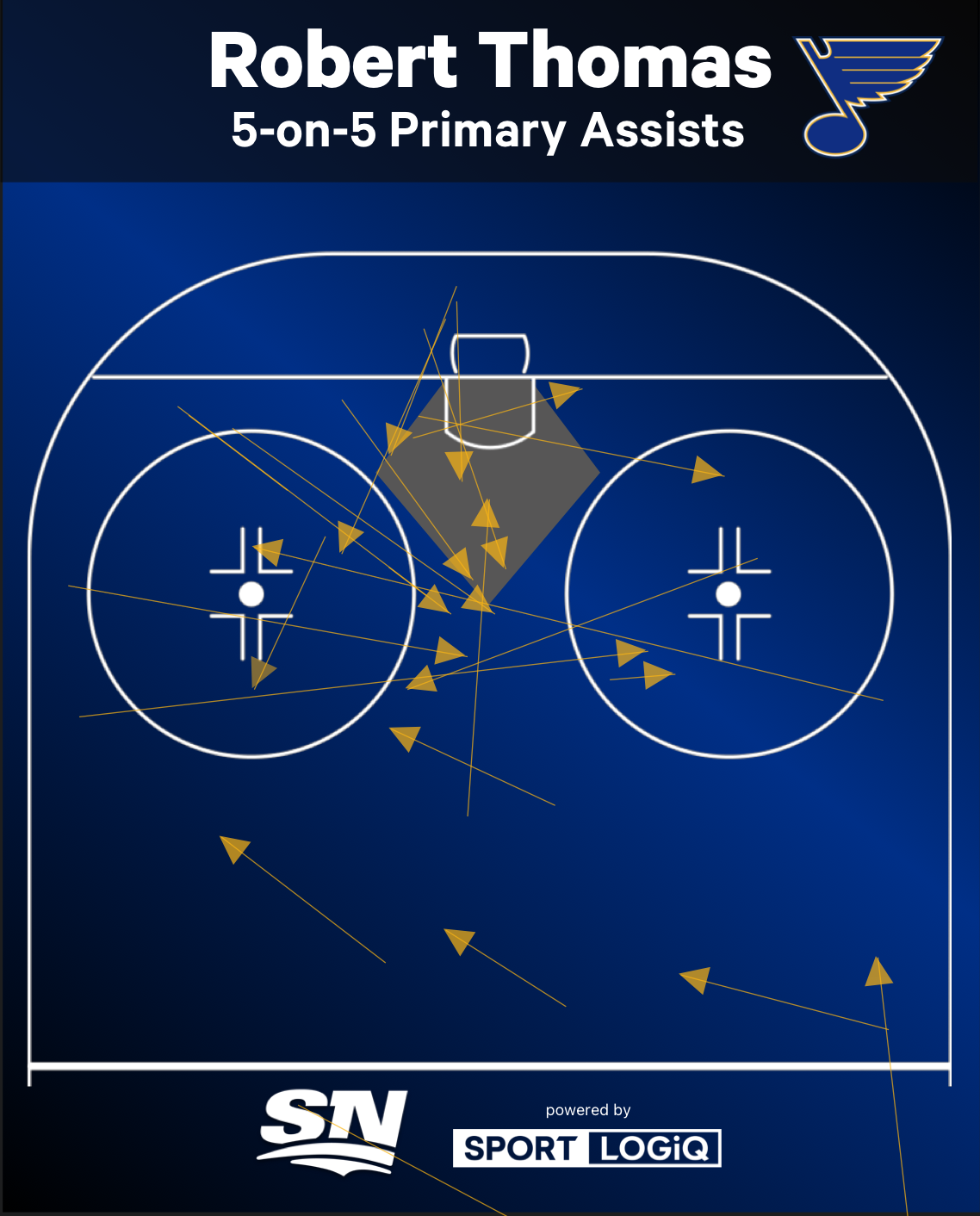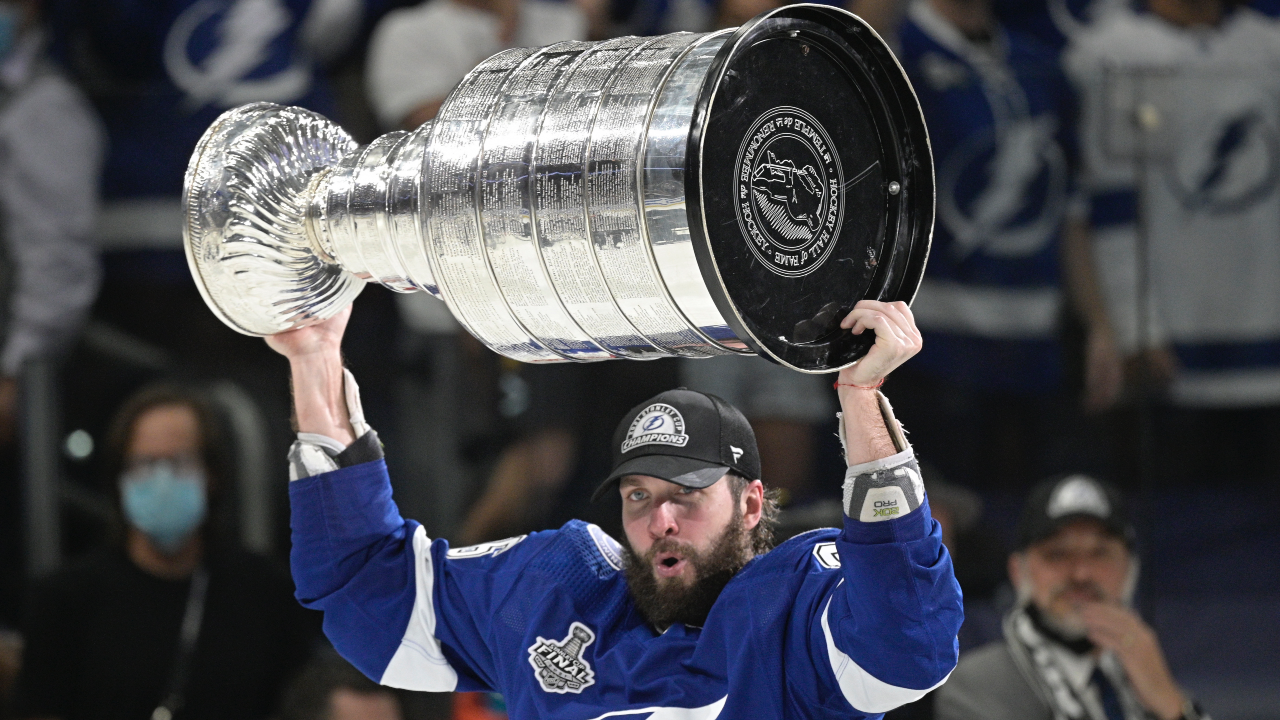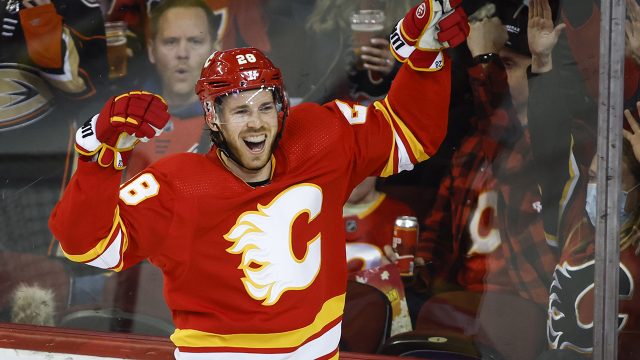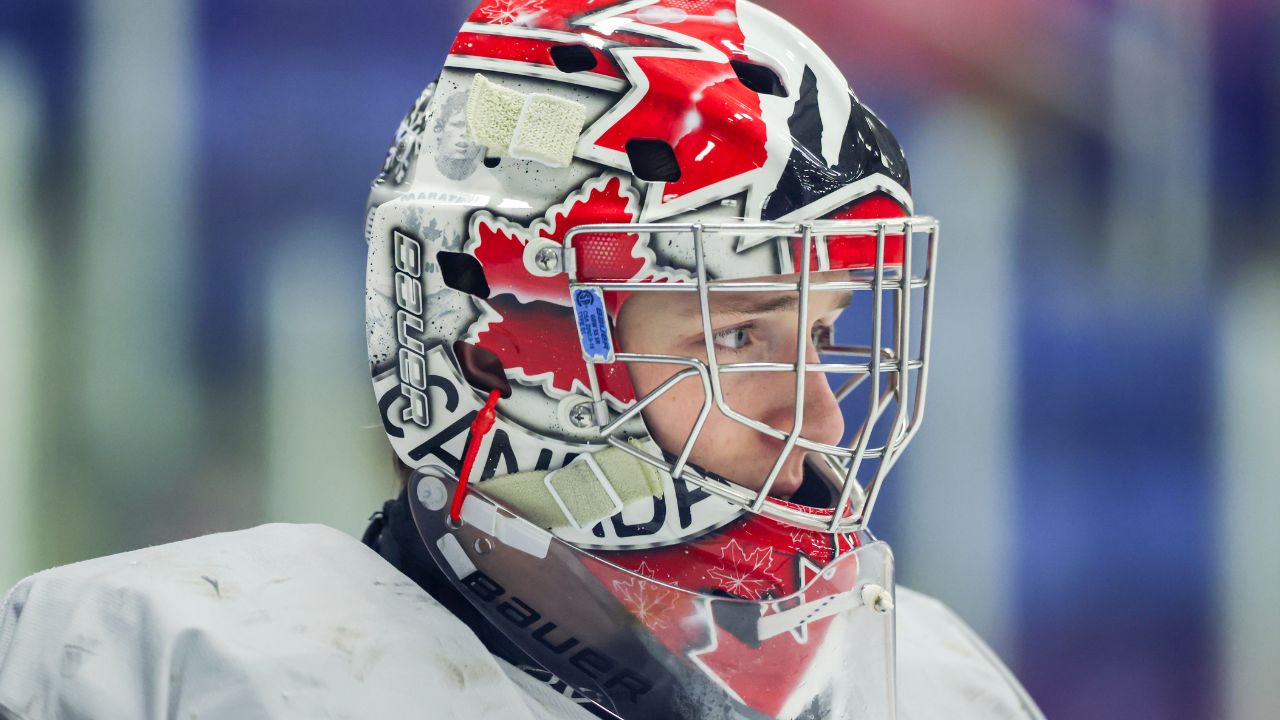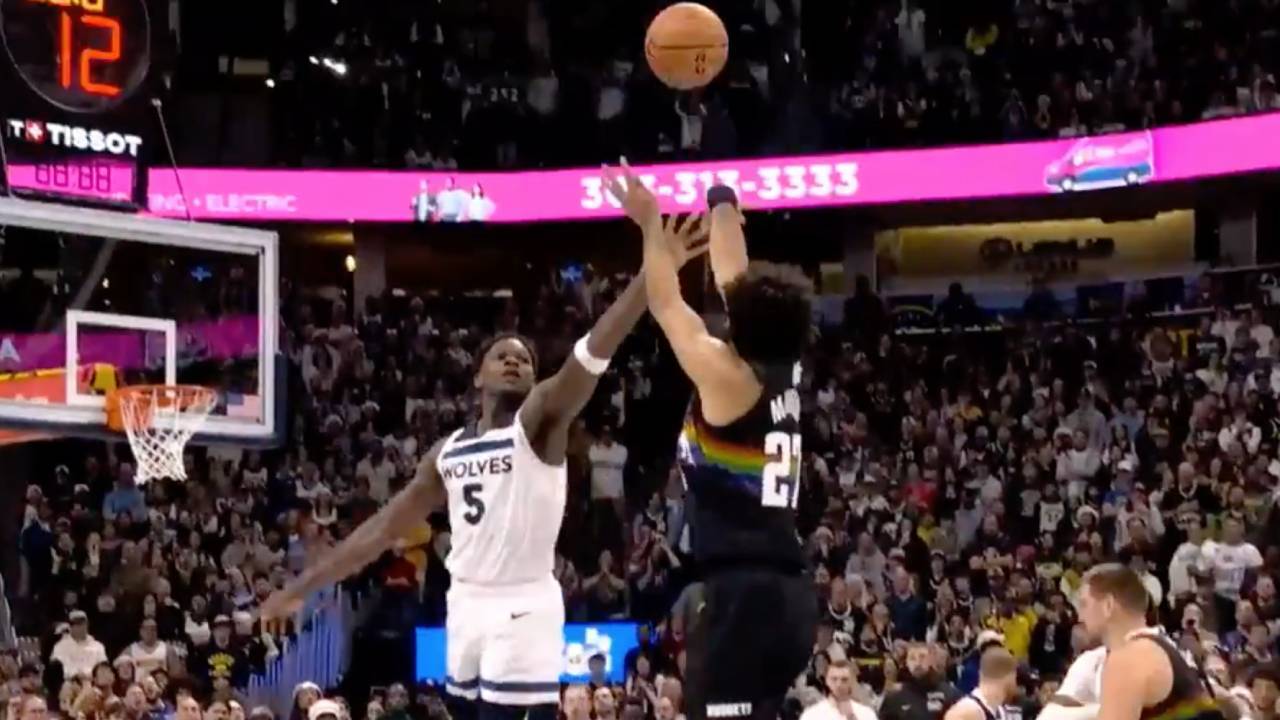
Players around the league have been making names for themselves this year, whether they’re showing a new aspect to their games or emerging as pivotal pieces of their teams.
Now that the 2021-22 season is in the homestretch, we can look back at some of the best breakout performances of the season.
Robert Thomas
With 18 goals and 66 points in 53 games, Thomas is cruising to a career-year in St. Louis. His growth has coincided with quite the boost in ice time, from 13:36 on average last year in all situations to just under 19 minutes a game this season. When accounting for that boost in his time, his scoring still is strides ahead of year’s past with a career-high 3.33 points per 60.
The aspect of his game that’s stood out above the rest is his playmaking. And it’s not popping only when he has extra time and space on the advantage. Rather, he’s breaking out as one of the best 5-on-5 passers in the league.
In terms of volume, Thomas has attempted almost 55 passes in the offensive zone per 60, which ranks 21st in the league. But above just his volume, it’s about his quality puck movement. Only one player has moved the puck to the slot at a higher rate than the Blues centre’s 18.3 attempts per 60: Mitch Marner’s league-leading 19.9 pass attempts per 60. With a 44.4 per cent accuracy, the 22-year-old also ranks second in completed passes to the slot.
That shines on the scoresheet as well. Thomas’ 23 primary helpers put him in a second-place tie with Matthew Tkachuk in 10 fewer games played. The only skater he trails is Johnny Gaudreau, who has 36 (also in 10 more games played).
Those results also reflect that puck movement to the slot, and those cross-crease threads, and those set ups to his teammates in the slot — often Vladimir Tarasenko, Pavel Buchnevich, Brandon Saad, and Jordan Kyrou.
It helps that he has such skillful shooters to pair that passing game with, but his impact is incredibly clear since he’s making the plays to facilitate their shooting.
Thomas’ growth this season has elevated the Blues’ offence, and made him a player to watch for years to come.
Tage Thompson
A shift to centre has done wonders for Thompson. The 6-foot-7 forward not only is crushing his previous milestones, but he’s jumped out as one of the best players in Buffalo.
He’s tallied 33 goals and 59 points in 71 games, both of which lead his team.
At 5-on-5, that offensive generation is generally concentrated to the quality areas of the ice. He’s second behind only Jeff Skinner in his rate of slot attempts, and those are split rush shots and a team-leading 3.19 slot attempts off the cycle per 60.
Of those 33 goals, 15 have come from the power play, where the righty tends to shoot from the left circle.
Obviously, as a 30-goal shooter, that’s where the emphasis on his game belongs. He’s generating quality chances and finishing (about 10 goals above expectations, to be exact). But he contributes before that shot as well. Thompson can help bring the puck over the blue line with control, and when the Sabes don’t have possession in the offensive zone, he can be counted on to help retrieve loose pucks even under pressure.
Troy Terry
Going into this season, Terry had just 15 goals and 48 points through 122 career games. This season alone in 68 matches, he’s net 33 goals and 59 points, more than doubling his prior numbers.
A boost in opportunity has played into it, with him averaging over 18 minutes a game in all situations now versus below 15 minutes in each previous year.
The red flags are him shooting over 20 per cent, when his career average including this spike is just 14.5 per cent. That’s helped him net 12.9 goals above expected. There’s room for improvement in the winger’s game, as well as on the team around him. But there are some really encouraging signs from his progress this season that show he can be a difference-maker on this club for years to come.
At 5-on-5, where he’s scored 19 of his goals, Terry kicks in 13.2 shot attempts per 60. About 57 come from the slot, which is one of the best concentrations to that area of the team.
Playing with two of the team’s most frequent 5-on-5 shooters has clearly clicked with Terry’s games. He spent most of the year alongside Ryan Getzlaf, who is second on the Ducks in offensive pass attempts (47.6 per 60) with a completion rate of over 60 per cent.
The winger as of late is seeing some time with Trevor Zegras, who rates highly in pass volume, and even better in quality with a rate of 10.3 per 60 pass attempts to the slot.
But his game isn’t entirely one-dimensional either, and that’s particularly important if there are sustainability concerns with his goal scoring. Terry rates highly in quality puck movement as well. So while the expectation may be for him to focus on his shooting, seeing as he’s net over 30 goals this season, having both options makes him all the more tricky to defend.
Jack Hughes
A wise man once pointed out that as soon as Jack Hughes started finishing more consistently, it would be over for everyone. And he was absolutely correct.
There’s been a lot of attention placed on Hughes, and rightfully so as a former first-overall pick. His first season fell short of expectations, but last year he trended in the right direction without the results to show for it. This season, however, he put it all together ahead of a season-ending injury.
No one brought the puck into the zone at 5-on-5 at a higher rate than Hughes and his 24.9 controlled entries per 60, primarily fuelled by carry-ins. Those entries resulted in a scoring chance about 28 per cent of the time, trailing only Gaudreau, Connor McDavid, and Nikolaj Ehlers.
The Devils centre’s job was far from finished in the offensive zone after bringing the puck in, though. No one created more slot shots off the rush than Hughes’ 4.8 per 60 at 5-on-5 this season.
But his offence wasn’t limited to just shooting, or rush plays either. His puck-moving shined this season as well with the fourth-best rate of passes to the slot at 16.6 per 60.
Between his puck-carrying abilities, playmaking, and shooting, he became the dual threat and star player that’s expected of him. And he’s only getting started.
Noah Dobson
The New York Islanders may have fallen below expectations this season, but there’s a few positive signs. First, they’ve turned it around in the second half and can have some confidence in this core moving forward. Second, Dobson has emerged as a key piece of this blue line.
Below Adam Pelech and Ryan Pulock there are some concerns about defenders with offensive upside on this team. A few subtractions over the years have set their defence back. While Dobson’s usage didn’t always reflect it earlier this season, his growth has made him a really valuable asset on the backend to help fill a need. And he’s managed while dragging around a declining Zdeno Chara through much of this year.
The 22-year-old has put up 10 goals and 41 points for the Islanders this season. At 5-on-5, where he’s earned just under half of his points, he can be counted on to help move the puck up the ice. He can exit the defensive end with control — whether he’s carrying the puck out himself, or sending a teammate a stretch pass. Once the Islanders drive into the offensive zone, he can contribute both passes and shots. Those point shots can come in handy on Long Island, seeing as this is a team with numerous forwards who can play a net-front role and deflect shots in.
That holds true on the power play as well, where he’s been stationed on the top unit. While Ryan Pulock was out of the lineup, he was the obvious choice to take over PP1. But he’s maintained it since the top pair defender returned to the lineup.
He can be trusted for that puck movement that boosts his 5-on-5 game, or to rip a one-timer from the point at a high rate. An important skill of his on the man-advantage is helping keep possession in the offensive zone, whether he blocks his opponents’ passes or holds the blue line; he ranks highly among other power-play quarterbacks around the league in preventing receptions from penalty killers.
Honorable Mentions: Michael Bunting, Mason Marchment, Oliver Kylington.
Data via Sportlogiq


